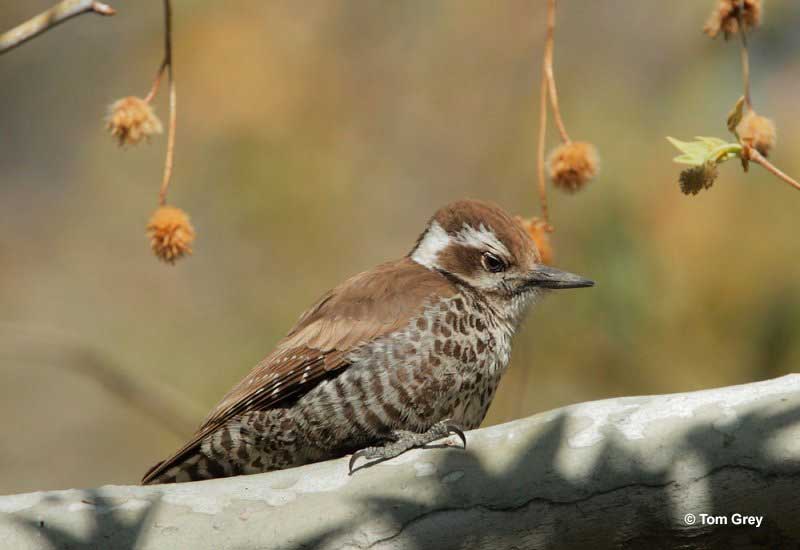Arizona Woodpecker (Leuconotopicus arizonae) is a small woodpecker that is dark brown above and has heavily spotted and barred underparts.
A small, brown woodpecker hitching up an oak tree in the mountains of southern Arizona will probably be this species.
Have you wondered how you can see an Arizona Woodpecker? Learn how and more about this woodpecker species in this article!
On this page
Identification
Male
Male Arizona Woodpeckers are a fairly small woodpecker species with a plain, dark brown back, and a big, dark brown patch on their white face. They have a lot of white on each side of their neck, and a small red patch on the back of their dark brown crown.
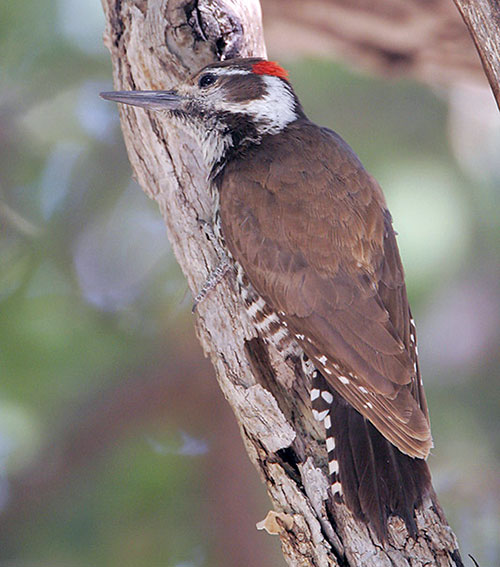
This bird also has a white throat, a small white eyebrow, and has a paler brown mark just above its sharp, straight beak.
This small woodpecker has a dark brown mustache and white underparts with lots of dark brown spotting on its chest, and dark brown barring on its belly and undertail.
Female
Female Arizona Woodpeckers are very similar to males. They have the same dark brown colors and are the same size. On average, both sexes are 7.5 inches long, have a 14 inch wingspan, and weigh 1.6 ounces.
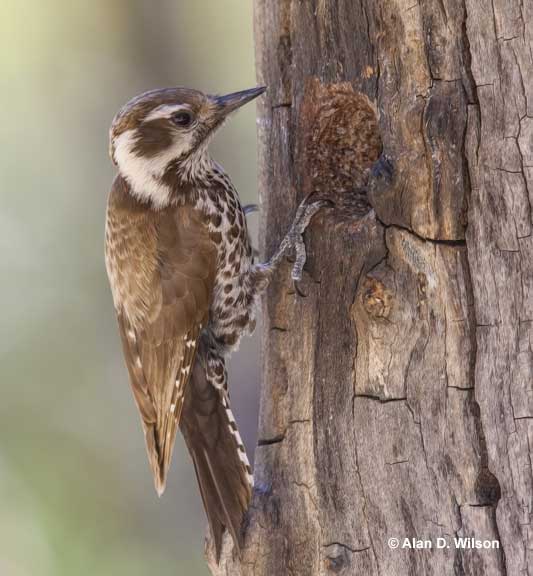
Female Arizona Woodpecker
The main way to tell the female Arizona Woodpecker from the male is by looking at the bird’s head. Adult females don’t have any red, while males always show a small red patch. Juveniles of both sexes have some red on their crown.
Related: Types of Woodpeckers in North America
As with males, perched females show some small white spots on their wings, and have dark tails with black and white outer tail feathers.
Vocalizations
Arizona Woodpeckers often make a sharp call a lot like other small woodpeckers. It sounds like, pik!…..pik!…..pik!. Both sexes make this sound while foraging, in flight, from a high perch, or other situations.
They also have a nasal rattling vocalization that mates can use to call to each other. These woodpeckers can also make this sound when they are alarmed or disturbed.
Arizona Woodpeckers also make other vocalizations, including tik calls, twittering sounds, and wicka wicka calls.
Food
Arizona Woodpeckers eat lots of larvae, beetles, and other insects. Their diet also includes some acorns and fruit, but they mostly depend on insects.
They can eat ants and other bugs but beetles seem to make up the largest part of their diet. These small woodpeckers feed on species of Long-horned Beetles, wood-boring beetles, and other types of beetles that attack trees.
With that in mind, Arizona Woodpeckers are important natural pest control agents that keep such wood-boring beetles in check. They catch these and other insects by picking them off of tree trunks and branches.
These woodpeckers usually forage by flying to the base of an oak, pine, or other tree, and then quickly hitch up the tree in a spiral pattern. When they reach the top, they fly down to another tree and do the same thing.
They can also feed on agave stalks and pick acorns or occasional berries.
Unlike many larger woodpecker species, the Arizona Woodpecker does not hammer deep holes into trees. Instead, it uses its sharp beak to flake off and pry up bits of bark, and to probe into crevices.
When it detects a beetle or other insect, it catches it with its long tongue or beak.
Nesting and Eggs
Arizona Woodpeckers begin courtship in March and usually have young by May.
Instead of using old nests, this woodpecker pecks out a new nest each breeding season. They often make their nest cavity on a dead branch of a walnut tree but can also use cottonwoods and various other tree species.
On average, the nest is 16 feet above the ground, although some are as low as two feet and others as high as 49 feet above the ground. The nesting cavity is also about a foot deep and the entrance hole is two inches wide.
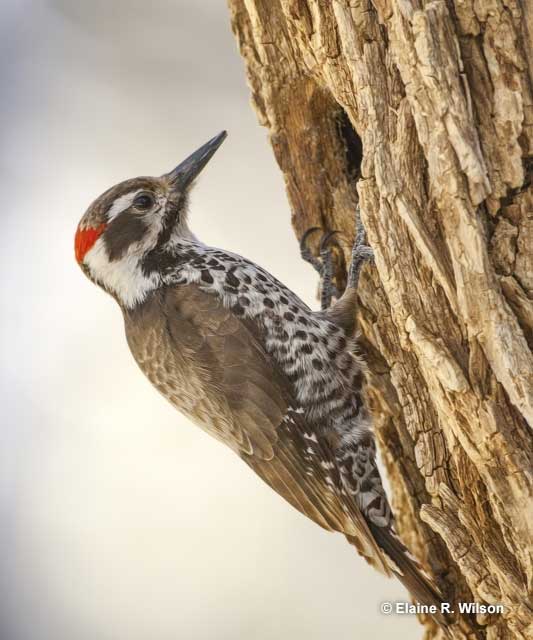
When the nest is ready, the female Arizona Woodpecker lays two to four, white, 0.94 inch long eggs directly on the floor of the cavity. She doesn’t add any vegetation or other nesting material to the nest.
Both parents incubate their eggs for 12 to 14 days and start feeding them shortly after the babies hatch. Although both parents feed them, males tend to bring more food than the female. Nearly four weeks after hatching, the young Arizona Woodpeckers leave the nest.
A few days after leaving the nest, the baby woodpeckers can feed themselves but still depend on their parents for two to three weeks more. By July, they become totally independent.
Current Situation
The Arizona Woodpecker occurs in pine-oak and sycamore woodlands at certain elevations in the mountains of southeastern Arizona and adjacent New Mexico. They may have a preference for riparian zones and occur above the Ladder-backed Woodpecker but below the Hairy Woodpecker. It also lives in similar habitats in western Mexico.
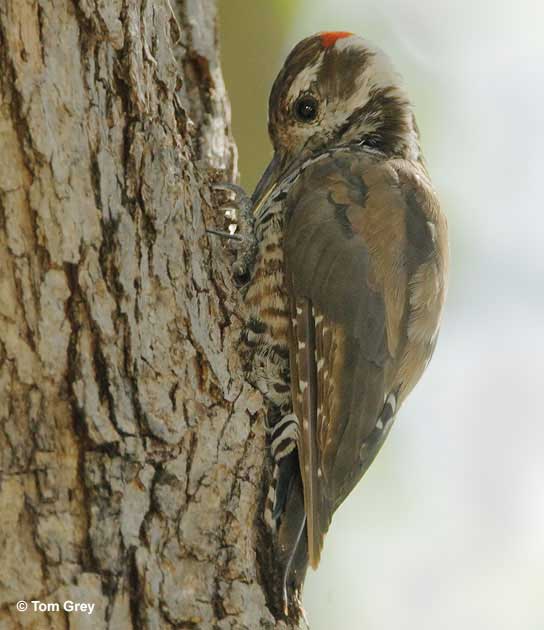
This species is listed as Least Concern in the IUCN Red List and is an uncommon bird.
Arizona Woodpeckers are not considered to be threatened. However, in Arizona and New Mexico, they are categorized as a sensitive species.
These woodpeckers have a very limited distribution in the USA and seem to require large areas of quality habitat.
Some biologists are concerned that overuse of ground water for agriculture could affect the Sycamore trees these birds depend on. They may also suffer from other types of habitat degradation. There is also concern that similar situations could be having a negative effect on this species in its Mexican range.
Facts
- The Arizona Woodpecker is one of several bird species that mostly live in western Mexico. These birds barely range north to the mountains of southeastern Arizona and adjacent New Mexico.
- This species is one of the least known birds in North America. The Arizona Woodpecker’s remote range and uncommon nature have made it very difficult to study it. For this reason, it’s not even known if the male woodpecker excavates the nesting cavity alone or if the female also helps out.
- This woodpecker species often forages in mixed flocks with Bushtits, Bridled Titmouse, and other small birds. It’s worth it for the woodpecker to flock with other small birds. While the Arizona Woodpecker focuses on finding beetles and other insects, the other birds give the alarm if they see a predator.
- The Arizona Woodpecker used to be known as the “Strickland’s Woodpecker”. However, that name has since been given to a closely related woodpecker species native to central Mexico.
Similar Species
The Arizona Woodpecker is one of the more distinctive woodpecker species in North America. However, there are a few other woodpeckers that live near or with it.
Ladder-backed Woodpecker
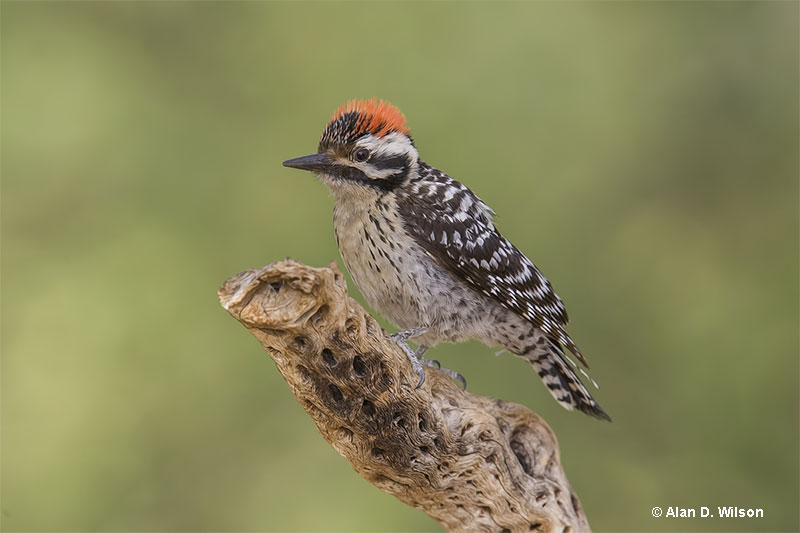
The Ladder-backed Woodpeckers can occasionally occur with the Arizona Woodpecker, especially in riparian zones. However, it has a “zebra-striped” black and white back, and lacks the dark brown colors of the Arizona Woodpecker.
Hairy Woodpecker
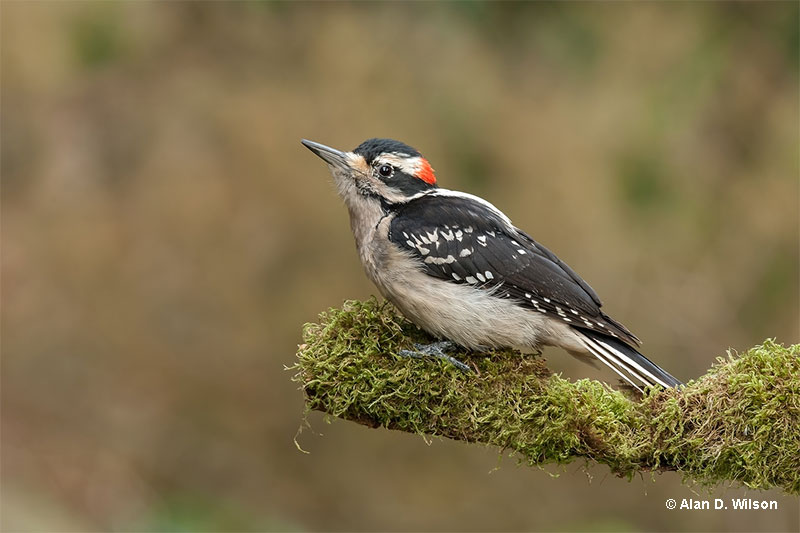
The Hairy Woodpecker usually occurs at higher elevations than the Arizona Woodpecker. However, they are sometimes seen in the same area. Instead of having dark brown plumage, Hairy Woodpeckers are black and white, and have all white underparts.
Northern Flicker

Northern Flickers can be seen in the same places as Arizona Woodpeckers. Like the Arizona Woodpecker, they also have brown in their plumage and have heavily marked underparts. However, Northern Flickers are much larger, have white rumps, barred backs, and other features to separate them from the Arizona Woodpecker.
Frequently Asked Questions
Where does the Arizona Woodpecker live?
The Arizona Woodpecker lives in in pine-oak forests in southeastern Arizona, southwestern New Mexico, and in the mountains of western and central Mexico.
What trees do Arizona Woodpeckers like?
Arizona Woodpeckers like oaks, pines, sycamores, and walnuts.
How long do Arizona Woodpeckers live for?
Arizona Woodpeckers can probably live for eight to twelve years.
Are woodpeckers good to have around?
Yes, woodpeckers are good to have around. They eat beetles and other insects that can damage trees and crops.

